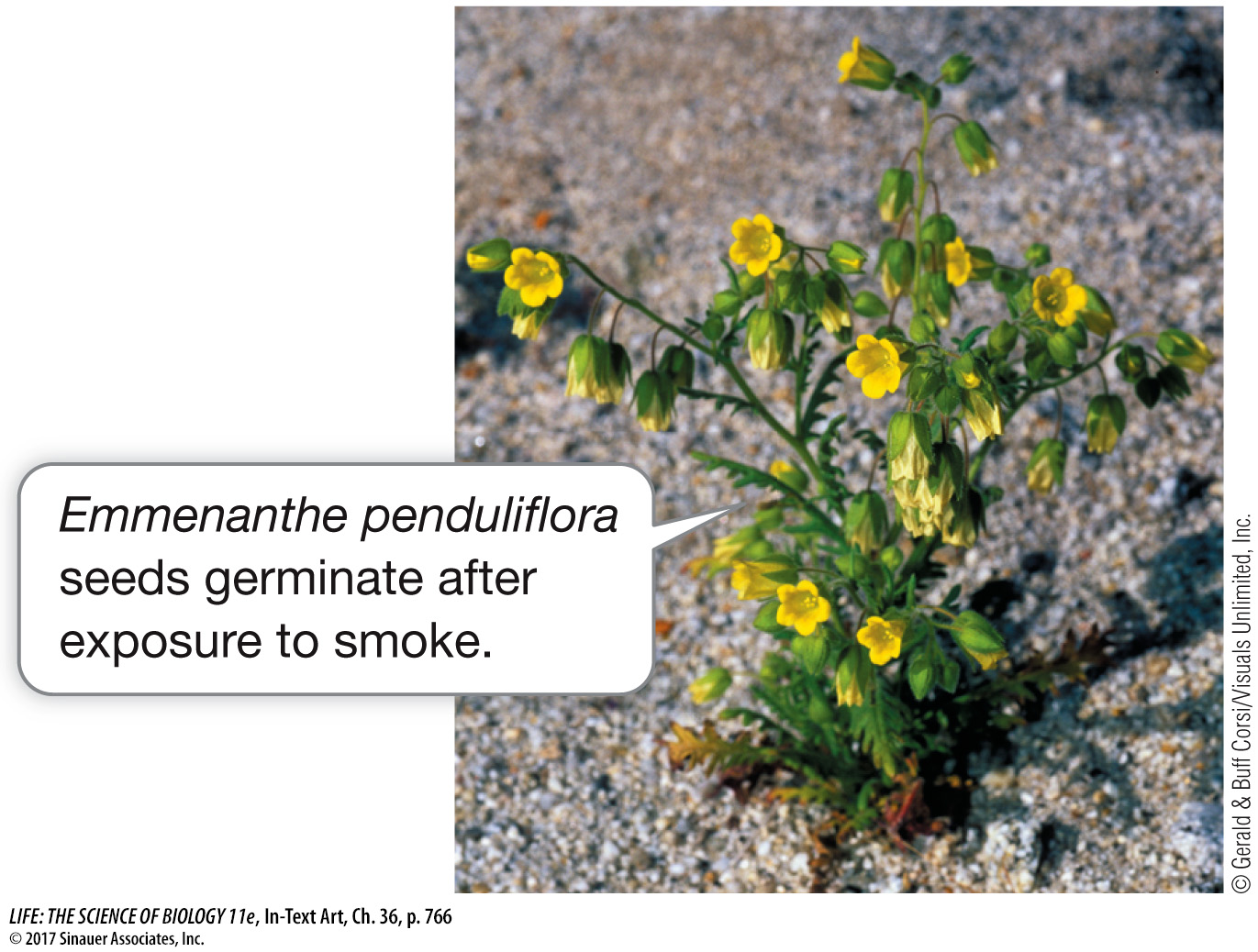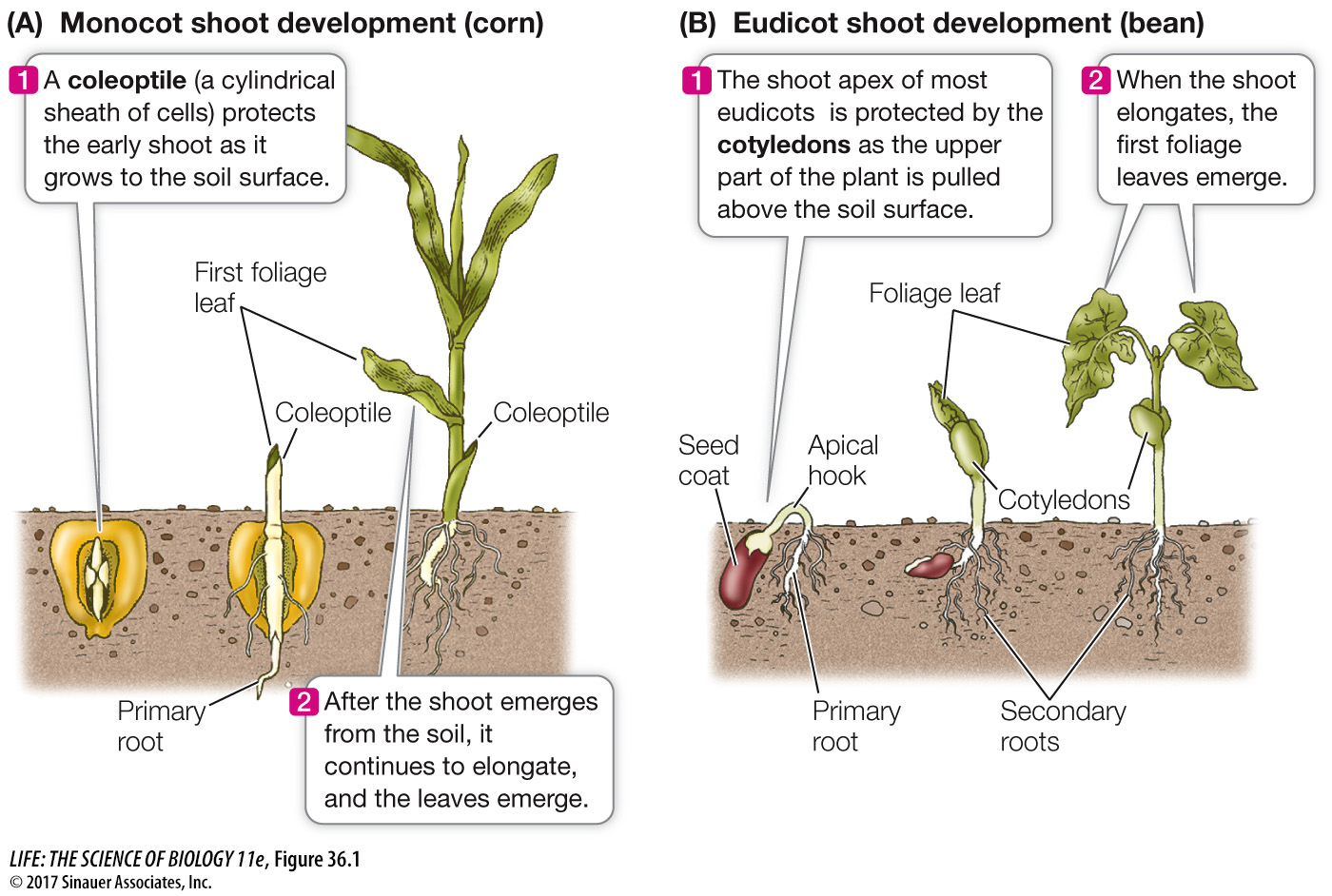In early development, the seed germinates and forms a growing seedling
Chapter 37 will describe the events of plant reproduction and development that lead to the formation of seeds. Here we begin with the seed, the structure that contains the early embryo. Unlike most animal embryos, plant seeds may be held in “suspended animation,” with the development of the embryo halted, for long periods. If development stops even when external conditions (such as water supply) are adequate for development, the seed is said to be dormant.
DORMANCY Seed dormancy may last for weeks, months, or years. Plants use several mechanisms to maintain dormancy:
Exclusion of water or oxygen from the embryo by an impermeable seed coat
Mechanical restraint of the embryo by a tough seed coat
Chemical inhibition of germination by growth regulators
Photodormancy: some seeds need a period of light or dark before they can germinate
Thermodormancy: some seeds need high or low temperatures to germinate
Dormancy can be broken by conditions that overcome these mechanisms. For example, the seed coat may be damaged by passage through an animal’s digestive system, or heavy rains may wash away chemical inhibitors. There are some unusual methods to overcome dormancy. One example is the breaking of dormancy by components of smoke. Emmenanthe penduliflora is a common plant in dry chaparral of the southwestern United States, an area that is prone to wildfires.

These plants germinate rapidly after a fire. John Keeley of Occidental College in Los Angeles found that dormancy in seeds of this plant is broken not by heat but by smoke—
Plant biologists distinguish between seed dormancy, which prevents germination under conditions that are suitable for plant growth, and seed quiescence, which occurs when a seed fails to germinate because conditions are unfavorable for growth. Some seeds may remain quiescent, yet viable, for centuries; botanists have germinated a 1,300-
Seed dormancy and quiescence are common, so they must provide selective advantages for plants. Dormancy ensures that the seed will germinate at a time suitable for the plant to complete its life cycle. For example, some seeds require exposure to a long cold period (winter) before they germinate in the spring; this ensures that the plant has the entire growing season to mature and set new seeds. Dormancy and quiescence also help seeds survive droughts or long-
GERMINATION Seeds begin to germinate, or sprout, when dormancy is broken and environmental conditions are satisfactory. The first step in germination is the uptake of water, called imbibition (from imbibe, “to drink in”). Before germination, a seed contains very little water: only 5–
As a seed takes up water, it undergoes metabolic changes: enzymes are activated upon hydration, RNA and then proteins are synthesized, the rate of cellular respiration increases, and other metabolic pathways are activated. In many seeds, cell division is not initiated during the early stages of germination. Instead, growth results solely from the expansion of small, preformed cells.
As germination proceeds, starch, proteins, and lipids that are stored in the seed are hydrolyzed to provide metabolic energy and chemical building blocks—
If the seed germinates underground, the new seedling must elongate rapidly (in the right direction!) and cope with a period of life in darkness or dim light. Photoreceptors that sense light and specialized cells that sense gravity direct this stage of development and prepare the seedling for growth in the light.
The pattern of early shoot development varies among the flowering plants. Figure 36.1 shows the shoot development patterns of monocots and eudicots. In monocots, the growing shoot is protected by a sheath of cells called the coleoptile as it pushes its way through the soil. In eudicots, the shoot is protected by the cotyledons.

Activity 36.1 Monocot Shoot Development
Activity 36.2 Eudicot Shoot Development